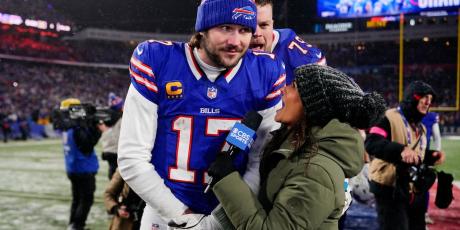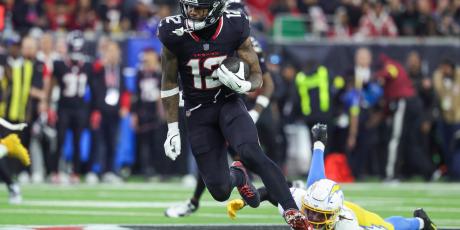Debunking the Super Bowl Hangover: The Case for Russell Wilson

One of my favorite quarterbacks heading into draft season is Seahawks QB and former Wisconsin signal-caller Russell Wilson. We currently have Wilson ranked #7 in standard formats, but he’s going in the #11 to #15 range depending on where you're drafting.
He’s a 25 year-old, Super Bowl-winning quarterback who has finished #9 and #8 at his position in his first two seasons in the league. While he lost Golden Tate in free agency, the return of Percy Harvin should more than make up for it.
Is the Offense a Problem?
So why is he being drafted so late? I asked this question on Twitter and was told that since he plays for a run-first team, he’s not going to get a ton of pass attempts or yardage. This is true. In 2013, he was #22 and #16 in those two categories, respectively. But he’s wonderfully efficient; the Seahawks posted the 3rd-highest fantasy points per pass attempt (FP/PA) in 2013, and that doesn’t even take into account ability to run the ball. He has 1,028 rushing yards and five rush TDs in two seasons. In short, Wilson doesn’t have to throw the ball a lot to be an effective fantasy quarterback.
The Seahawks will continue to be a run-first team, but there are reasons to believe that they’ll pass the ball more in 2014. They know what they have in Wilson, and he has the trust of offensive coordinator Darrell Bevell. The Seahawks threw the ball 3.5% more in 2013 when compared to 2012, and the aforementioned return of Percy Harvin may encourage further growth.
Consistency
I was also told by his detractors that he’s a week-to-week worry (i.e. he’s not consistent). But when I ran the numbers, I found that his 2013 Coefficient of Variation (which is calculated by dividing the standard deviation by the mean) was 34%, which was the 5th-best at his position last year.
He’s also shown significant improvement since the first half of the 2012 season. When his last 30 games are considered (including the playoffs), he has averaged 19.0 FP, which is more than what Cam Newton averaged as the #3 QB in 2013.
Super Bowl Hangover?
The last thing I wanted to test for was a Super Bowl hangover. The theory is that a quarterback won’t play as well in the first season after winning the Super Bowl, due to fatigue, complacency, free agency, regression, or any number of other theoretical factors. I looked at the last 30 Super Bowl-winning quarterbacks to see how they fared, fantasy-wise, the following year.
Following Year Super Bowl-Winning QB Performance
| YEAR | TEAM | QB | G | FP | PPG | G (Y+1) | FP (Y+1) | PPG (Y+1) | PPG DIFF |
|---|---|---|---|---|---|---|---|---|---|
| 2012 | Ravens | Joe Flacco | 16 | 234.9 | 14.7 | 16 | 207.6 | 13.0 | -12% |
| 2011 | Giants | Eli Manning | 16 | 279.8 | 17.5 | 16 | 232.9 | 14.6 | -17% |
| 2010 | Packers | Aaron Rodgers | 15 | 302.5 | 20.2 | 15 | 392.4 | 26.2 | 30% |
| 2009 | Saints | Drew Brees | 15 | 296.4 | 19.8 | 16 | 264.2 | 16.5 | -16% |
| 2008 | Steelers | Ben Roethlisberger | 16 | 177.4 | 11.1 | 15 | 266.3 | 17.8 | 60% |
| 2007 | Giants | Eli Manning | 16 | 185.3 | 11.6 | 16 | 197.5 | 12.3 | 7% |
| 2006 | Colts | Peyton Manning | 16 | 311.5 | 19.5 | 16 | 271.1 | 16.9 | -13% |
| 2005 | Steelers | Ben Roethlisberger | 12 | 168.3 | 14.0 | 15 | 183.3 | 12.2 | -13% |
| 2004 | Patriots | Tom Brady | 16 | 227.5 | 14.2 | 16 | 251.3 | 15.7 | 10% |
| 2003 | Patriots | Tom Brady | 16 | 212.1 | 13.3 | 16 | 227.5 | 14.2 | 7% |
| 2002 | Buccaneers | Brad Johnson | 13 | 197.0 | 15.2 | 16 | 213.5 | 13.3 | -12% |
| 2001 | Patriots | Tom Brady | 15 | 156.3 | 10.4 | 16 | 244.6 | 15.3 | 47% |
| 1999 | Rams | Kurt Warner | 16 | 320.3 | 20.0 | 11 | 186.9 | 17.0 | -15% |
| 1997 | Broncos | John Elway | 16 | 250.2 | 15.6 | 13 | 190.0 | 14.6 | -7% |
| 1996 | Packers | Brett Favre | 16 | 306.6 | 19.2 | 16 | 284.4 | 17.8 | -7% |
| 1995 | Cowboys | Troy Aikman | 16 | 188.4 | 11.8 | 15 | 155.2 | 10.3 | -12% |
| 1994 | 49ers | Steve Young | 16 | 350.1 | 21.9 | 11 | 226.0 | 20.5 | -6% |
| 1993 | Cowboys | Troy Aikman | 14 | 177.5 | 12.7 | 14 | 145.2 | 10.4 | -18% |
| 1992 | Cowboys | Troy Aikman | 16 | 214.3 | 13.4 | 14 | 177.5 | 12.7 | -5% |
| 1991 | Redskins | Mark Rypien | 16 | 230.2 | 14.4 | 16 | 162.3 | 10.1 | -29% |
| 1990 | Giants | Phil Simms | 14 | 148.5 | 10.6 | 6 | 69.9 | 11.7 | 10% |
| 1989 | 49ers | Joe Montana | 13 | 260.5 | 20.0 | 15 | 248.0 | 16.5 | -17% |
| 1988 | 49ers | Joe Montana | 14 | 199.4 | 14.2 | 13 | 260.5 | 20.0 | 41% |
| 1987 | Redskins | Doug Williams | 5 | 84.1 | 16.8 | 11 | 140.4 | 12.8 | -24% |
| 1986 | Giants | Phil Simms | 16 | 183.7 | 11.5 | 9 | 139.6 | 15.5 | 35% |
| 1985 | Bears | Jim McMahon | 13 | 180.2 | 13.9 | 6 | 64.0 | 10.7 | -23% |
| 1984 | 49ers | Joe Montana | 16 | 257.0 | 16.1 | 15 | 256.4 | 17.1 | 6% |
| 1983 | Raiders | Jim Plunkett | 14 | 162.2 | 11.6 | 8 | 68.3 | 8.5 | -26% |
| Totals | 14.8 | 223.7 | 15.2 | 13.6 | 204.5 | 14.8 | -0.70% |
I removed John Elway (1998) and Trent Dilfer (2000) since Elway retired and Dilfer changed teams, so there are 28 quarterback seasons in the study. The average difference in PPG year-over-year is -0.7% (averaging the % Diff) or -2.5% (when looking at the difference in the average PPG of the subset). This seems negligible, though 18 of the 28 QBs did see a drop in per game production the year after winning the Super Bowl. I believe Wilson’s youth and professionalism will allow him to progress since he’s still improving as a player and isn’t the type that is going to be complacent after achieving one of his primary goals.
Bottom Line
If his ADP is to be believed, Wilson should be available in the 8th round or later on draft day. His positional rank means that he may be available even later (10th?); savvy fantasy owners can often wait an extra round or two to draft the 12th QB off the board since none of the other owners will be in the market for a passer at that point in the draft. The vast majority of owners will fill out their starting lineup and draft backups at both running back and receiver before drafting a second quarterback.
Given his track record, Wilson is a tremendous value in the 9th or 10th round. Owners targeting Wilson at this point can focus on the other positions before selecting him in the middle rounds, adding a quality, low-risk QB to an already-stacked roster.






















